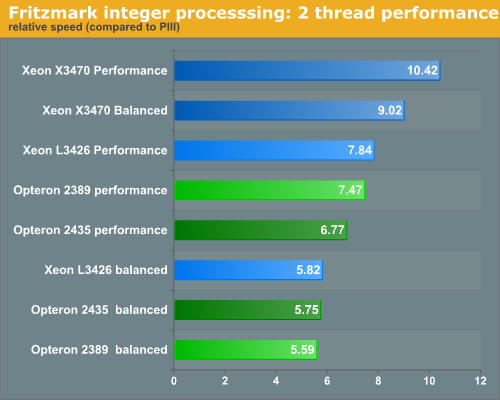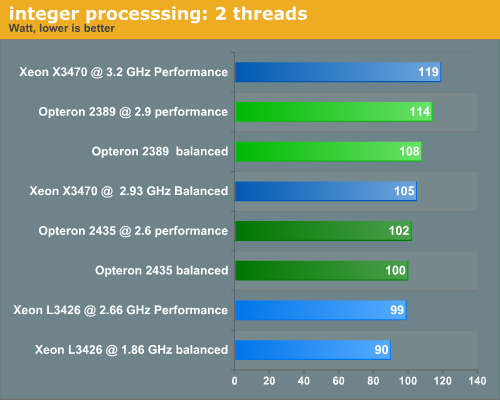Dynamic Power Management: A Quantitative Approach
by Johan De Gelas on January 18, 2010 2:00 AM EST- Posted in
- IT Computing
Saving Power at Low Load
Measuring idle power is important in some applications as operating system schedulers may choose to "race to idle", i.e. perform the task as quickly as possible so the CPU can return to an idle state. This strategy is only worthwhile if the idle state consumes very little power, but lots of server applications are running at relatively low but almost never "zero" load. One example is a web server that is visited all around the globe. Thus it is equally interesting to see how the processors deal with this kind of situation. We started Fritz Mark up with two threads to see how the operating system and hardware cope with this. First we look at the delivered performance.

In performance mode, the Xeon L3426 is capable of pushing clock speed up to 2.66GHz, but not always. Performance is equal to a similar Xeon at 2.5GHz. This in contrast with the Xeon X3470 which can almost always keep its clock speed at 3.33GHz, and as such delivers performance that is equal to a Xeon that would run always at that speed. The reason for this difference is that the PCU of the L3426 has less headroom: it cannot dissipate more than 45W while the X3470 is allowed to dissipate up to 95W. Still, the performance boost is quite impressive: Turbo Boost offers 34% better performance on the L3426 compared to the "normal" 1.86GHz clock.
Now let's confront the performance levels with the power consumption.

The six-core Opteron is clearly a better choice than its faster clocked quad-core sibling. In power saving mode it is capable of reducing the power by 8W more while offering the same level of performance. It is a small surprise: do not forget that the "Istanbul" Opteron has twice as many idle cores that are leaking power than the "Shanghai" CPU.
The Nehalem based core offers very high performance per thread, about 40% higher than the Opteron's architecture is capable of achieving, but it does come with a price, as we see power shoot up very quickly. Part of the reason is of course is that the Nehalem is more efficient at idle. We assume - based on early component level power measurements - that the idle power of the Xeons is about 9W (power plan Balanced), the Opterons about 14W (power plan Balanced). Note that the exact numbers are not really important. Since the RAM is hardly touched, we assume that power is only raised by 1W per DIMM on average. Based on our previous assumptions we can estimate CPU + VRM power, measured at the outlet.
| System Power Estimates | |||
| System | Power Calculation | CPU + VRM Power | Notes |
| Xeon X3470 performance | 119W - 4W (4 x 1W per DIMM) - 60W idle + 13W CPU | = 68W | (idle power of system was 73W = 13W CPU, 60W for the rest of the system) |
| Xeon L3426 performance | 99W - 4W - 60W + 11W | = 46W | |
| Xeon L3426 | 90W - 4W - 60W + 9W | = 35W | |
| Opteron 2435 performance | 102W - 4W - 70W idle + 18W | = 42W | (total idle power was 88W, 18W CPU) |
| Opteron 2435 balanced | 100W - 4W - 70W idle + 14W | = 40W | |
| Opteron 2389 performance | 114W - 4W - 70W idle + 22W | = 62W | |
First of all, you might be surprised that the Turbo Boosted L3426 needs 46W. Don't forget this is measured at the power outlet, so 46W at 90% efficiency means that the CPU + VRMs got 41W delivered. Yes, these numbers are not entirely accurate, but that is not the point. Our component level power measurements still need some work, but we have reason to assume that the numbers above are close enough to draw some conclusions.
- AMD's platform consumes a bit too much at idle, but...
- The six-core Opteron CPUs are much more efficient than the quad-core in these circumstances
- Intel's 95W Xeons offer stellar performance but the high IPC requires quite a bit of power
- The low power versions offer an excellent performance / Watt ratio
So if we take the platform out of the picture, the low power Xeon with Turbo Boost consumes about the same as the "normal" six-core Opteron, but performance is 16% better. Is this a success or a failure? Did Intel's Power Controller Unit save a considerable amount of power? Or in other words, would the power of the Xeons be much higher if they didn't have a PCU? Let's dive deeper.










35 Comments
View All Comments
UrQuan3 - Thursday, January 21, 2010 - link
I'm trying to remember for 2008, but wasn't there a way to either force or suggest thread/core affinity? It looks like the scheduler was hopping all over the place on the Opterons.JarredWalton - Thursday, January 21, 2010 - link
You guys better pay attention and answer this post, or his species will try to enslave and/or wipe out the entire galaxy! ;-)mino - Wednesday, January 20, 2010 - link
I mean, not, why do you use them for this article.They are fine examples of low-power platforms, even if from vastly different markets.
But,
WHY ON EARTH DO YOU KEEP TALKING LIKE THEY WERE COMPARABLE THROUGHOUT THE ARTICLE ???
IntelUser2000 - Wednesday, January 20, 2010 - link
By the way, I don't know if you have the settings wrong or that's how it works, the Turbo Boost mode is not affected on the Home PC versions of Windows. Balanced uses Turbo Boost just as well on my Windows 7 Home Premium with Core i5 661.JarredWalton - Wednesday, January 20, 2010 - link
I was wondering this as well, but I'm not familiar with Windows Server... what I do know is that Power Saver on consumer Windows OSes really limits the CPU frequency scaling features, and it sort of looks like Balanced on the Server OS has aspects of consumer "Power Saver" as well as some elements of "Balanced". Odd to see only two power settings available, where Win7 now has at least 3 and often 5.mino - Wednesday, January 20, 2010 - link
It seems a classic example of KISS strategy of choosing the most-sensible options and so reducing decision complexity for IT people.Modes like "Max battery" have anyway no reason for existence on a server box.
RobinBee - Tuesday, January 19, 2010 - link
If you use your pc as a music server:Power saving methods ruin sound quality even if using a good sound card. The problem is »electronic« sound distortion. I do not know why this happens.
Also: The chosen number of IRQ pr. second in a net card can ruin sound quality too. Why, I do not know.
Anato - Tuesday, January 19, 2010 - link
I'm interested to see results from different operating systems which may be better at controlling processes in different CPU's. Namely no CPU hopping and is their power management as efficient as Windows is.Most interested at:
Linux and Solaris
JohanAnandtech - Tuesday, January 19, 2010 - link
Excellent suggestion :-). Problem is to keep the application the same. We currently tested SQL Server 2008 on Windows 2008 and of course this can not be done on Linux. However, I am not stranger to linux as a server.I am no fan of MySQL on Windows, but maybe this has improved. Would MySQL on Windows and Linux makes sense as a comparison?
maveric7911 - Tuesday, January 19, 2010 - link
Why not use oracle ;)